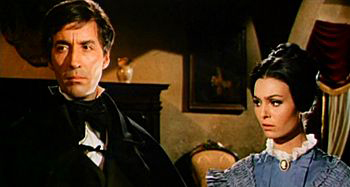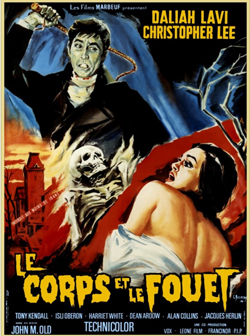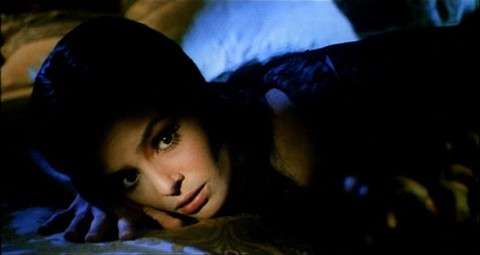|
|
Reviewed by Glenn Erickson
The wave of Euro-horror that tapped the commercial market opened by England's Hammer Films very quickly spread out into a full range of art and exploitation efforts. For a few years the top of the field was dominated by the established Italian director Riccardo Freda and the cameraman-turned director Mario Bava, with Antonio Margheriti turning in a couple of impressive shows as well. Between 1959 and 1966 there were perhaps a dozen core classic Italo horrors that incorporated beautiful cinematography and dreamy, delirious atmospherics in their horror content. The key word is oneiric, and very often the appeal of a film could be defined by isolated images, often involving the hauntingly erotic presence of Barbara Steele.
Freda's daringly transgressive The Horrible Dr. Hichcock with Steele was released in rich Technicolor. But just the next year Mario Bava's prodigious color lighting skills raised the bar for horror imagery far higher. The visually intoxicating Black Sabbath shows Bava to be the master of color imagery in the service of the fantastic. We'd seen his marvelous color work in pictures like Hercules Unchained, but not even Hammer films were as skilled at pulling scares out of brightly colored images. Maestro Bava immediately followed up with The Whip and the Body (La frusta e il corpo), a startlingly original scare show with an unexpectedly adult theme: sadomasochism. The lead role would seem perfect for Barbara Steele, but it went instead to the exotic Dahlia Lavi.

The film opens with the silhouette of a rider on the beach at sunset. Black sheep Kurt (Christopher Lee) returns to his seaside castle home bearing nothing but his noble title and a reputation for wickedness. Kurt's father repudiates him, as does the maid Giorgia (Harriet White Medin). She blames him for the suicide of her daughter years before, and even keeps the dagger in a glass case. The beauty of the household is Nevenka (Daliah Lavi), Kurt's sister-in-law. She also fears and loathes the sexually threatening Kurt, who immediately destabilizes the household. Accosting Nevenka on the beach, Kurt roughs her up. Taking her riding crop, he whips her until her clothes are torn and bloody -- and she likes it! The relationships become even more complicated as murders in the castle indicate Kurt as the obvious culprit. But nothing about the romantic, obsessive Nevenka is so simple.
Although not explicit in its depictions, The Whip and the Body is one of the most adult and erotically conceived horror films of the 1960s. Unlike the censor-restricted Hammer output, Italian horror steered in a definitely non-kiddie direction, and this film and The Horrible Dr. Hichcock are over-achieving eye-openers. Daliah Lavi is much more than a Barbara Steele substitute in this film, as some have labeled her. She's less of an icon to swoon over than Steele, but a somewhat more expressive actress. Freda's Hichcock was a clever collection of horror and Hitchcock conventions masking a profoundly perverted theme; The Whip and the Body masquerades as a stock Gothic and develops into something much more sophisticated. The primary writer on both films is Ernesto Gastaldi, working under the name Julian Berry.

A good point of comparison is the celebrated Deborah Kerr movie The Innocents, an upscale horror film from the Henry James novel The Turn of the Screw. In the book, the supernatural haunting of a governess remains ambiguous. We don't know if the children are really possessed by specters, or if they are just the hysterical distortions of the governess's mind. The movie version has a tougher time retaining its ambiguity. Since we experience the ghost right along with Deborah Kerr, the movie pretty much abolishes all doubt by letting us conclude that she is off her rocker. The illusions are the creations of her fevered, sexually frustrated mind. 4
Deprived of a literary context or intimidating star power, The Whip and the Body manages to be as psychologically valid as The Innocents. It may even be better cinema, as Bava's camera does most of the storytelling, seducing us with richly colored and textured images. As the 'facts' of the haunting become more contradictory, the more closely we must watch Nevenka's behavior. Bava and screenwriter Gastaldi eventually reveal Nevenka's true nature through a "dual reality" stylistic device that's just plain great filmmaking.

The leading players offer intense, unusual performances. The stunningly beautiful Dahlia Lavi broods over her secret sins while cowering in fear and trepidation. Christopher Lee is nicely shaded as a domineering, wanton aristocrat well aware that his violent behavior fulfills Nevenka's twisted desires. At the height of his creative powers, Mario Bava makes this one of his most sensitive works. The nocturnal wanderings down creepy corridors, a given in this branch of the genre, are exceptionally expressive. The disturbing whippings are the only real sex on view, yet they give the film a weird sadistic/erotic charge. Nevenka's relationship with the mysteriously resurrected Kurt is essentially a loving one, if violently perverse.
The movie was released when Italo producers were still trying to pass their work off as English in origin, so almost all of the on-screen credits are bogus. Co-producer Elio Scardimagia was reduced to "John Oscar". Mario Bava is saddled with the obviously fake name "John M. Old." Several of Bava's films were signed with these alternate names, making it difficult for casual reviewers and critics of the '60s and '70s to collate his films as the work of a single artist. This surely accounts for years of delay in the critical assessment of Bava in the English language.
In 1993, the American Cinematheque screened a 35mm Technicolor print in fine condition of this once-rare classic title, which at the time the film was virtually un-seeable in any reasonable form. The print was entitled What!, as it had been in murky grey-on-grey B&W prints that began being shown on TV less than a year after the film's almost invisible U.S. theatrical run. Capsule TV reviews used the title What! as its own capsule review -- the censor cuts were so severe that one couldn't tell who was doing what to whom. Few could have guessed that the original is one of the very best Italian horror films.

The Kino Lorber Classics Blu-ray of The Whip and the Body is a curious release of this highly-desirable Italo classic. The best previous disc available for American video had been a VCI disc from 2001, that was flat-letterboxed and rather dull in appearance. A 2005 Region 2 e.m.s German DVD with the title Der dämon und die jungfrau is widescreen-enhanced, richly colored and sharp enough to pick out occasional eccentricities in Mario Bava's in-camera effects work. In the very first moments of the film, Bava cuts two shots together of Kurt galloping down the beach; in the second shot the imposing Menliff castle is added as a silhouetted foreground miniature or cut-out. The angles are almost identical: although they are supposed to represent different views, they look like before & after examples of Bava's special effects. The castle almost 'pops' on screen.

The new Blu-ray betters other recent Bava releases from Kino by virtue of containing multiple audio tracks. The audio is excellent, with Carlo Rustichelli's romantic score making a big contribution to Nevenka's disturbed, delirious state. But the color transfer would appear to be terribly wrong, as has been the case with many of the new Hammer Blu-rays from England. Previous transfers, trailers and still images in Tim Lucas's mighty Mario Bava Book all exhibit Bava's signature lighting style, with a rich, oversaturated spectrum of colors, especially primary hues. Every shot is a work of beauty, with fine textures and warm flesh tones under normal lighting conditions. In the Kino disc the image is much darker and bluer than expected and most skin tones are purplish and cold. Scenes previously in half-light are now plunged into darkness, with no detail in shadows. Colors not completely repressed are greatly subdued. An insert shot of a dagger on the floor has a slight smear of something, which on previous prints was a splash of crimson blood. On the VCI and e.m.s. discs, one absolutely killer close-up of Nevenka rising from her bed (just above) is a masterpiece of color contrasts and sensual textures. The new Kino disc reduces the shot to just a couple of tones. Instead of a gradient of shadow densities, we get one dull black wherever the key light falls away.
The Whip and the Body still plays as a fascinating horror film, but not with the same visual impact, which is a big component of the appeal of Mario Bava. Note: the images here are not from the new Kino Blu-ray.
The main title on Kino's version is the French Le corps et le fouet. A French trailer in terrible condition is present along with trailers for several other Kino Bava releases. Making a welcome return from the old VCI disc is Tim Lucas's entertaining and densely informative commentary. He goes deep into the backgrounds of various cast members, which include the "Italian Peter Lorre" Luciano Pigozzi, Ida Galli (often known as Evelyn Stewart) and our favorite Harriet White Medin, an American whose adventure in Italian filmmaking began when she stayed on after a USO tour and took a role in Roberto Rossellini's neorealist classic Paisan.
On a scale of Excellent, Good, Fair, and Poor,
The Whip and the Body Blu-ray rates:
Movie: Excellent
Video: Fair
Sound: Excellent
Audio: Italian, French, English
Supplements:
Deaf and Hearing Impaired Friendly?
YES; Subtitles: English
Packaging: Keep case
Reviewed: December 14, 2013
Republished by permission of Turner Classic Movies.

DVD Savant Text © Copyright 2013 Glenn Erickson
See more exclusive reviews on the Savant Main Page.
Reviews on the Savant main site have additional credits information and are often updated and annotated with reader input and graphics.
Also, don't forget the
2011 Savant Wish List.
T'was Ever Thus.
Return to Top of Page
|

